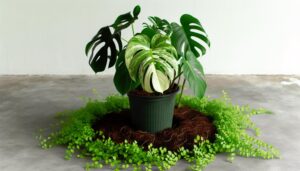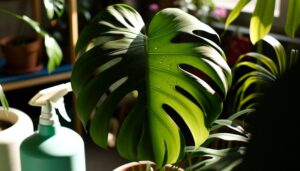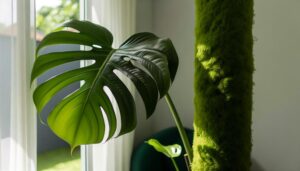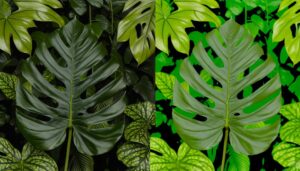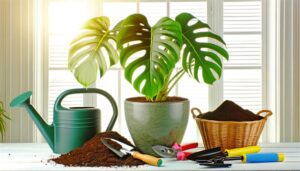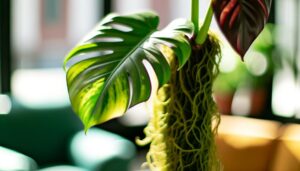Monstera Borsigiana Vs Thai Constellation
Monstera Borsigiana and Thai Constellation differ in key aspects such as origins and morphology. Monstera Borsigiana, from Central and South America, has deep green leaves and rapid growth due to higher chlorophyll.
Thai Constellation, developed in Thailand through tissue culture, features marbled variegation and larger leaves but grows more slowly. Both require well-draining, nutrient-rich soil and thrive in temperatures of 65-80°F.
Ideal humidity ranges between 60-80%. Variegation patterns also differ, with Thai Constellation displaying stable variegation due to genetic consistency.
By understanding these distinctions, you can optimize their growth and care.
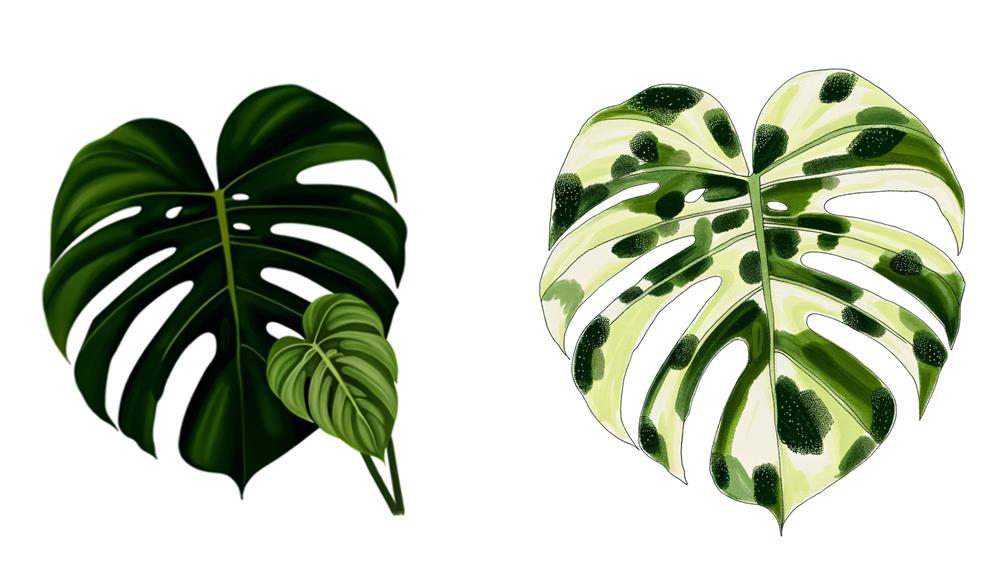
Key Takeaways
- Monstera Borsigiana has deep green leaves, while Thai Constellation features variegated marbled leaves.
- Monstera Borsigiana grows faster due to higher chlorophyll content compared to Thai Constellation.
- Thai Constellation leaves can reach up to 24 inches, larger than Monstera Borsigiana's 12-18 inches.
- Thai Constellation exhibits stable variegation patterns, whereas Monstera Borsigiana's variegation is irregular.
- Both plants require well-draining, nutrient-rich soil and frequent watering during growth phases.
Origins
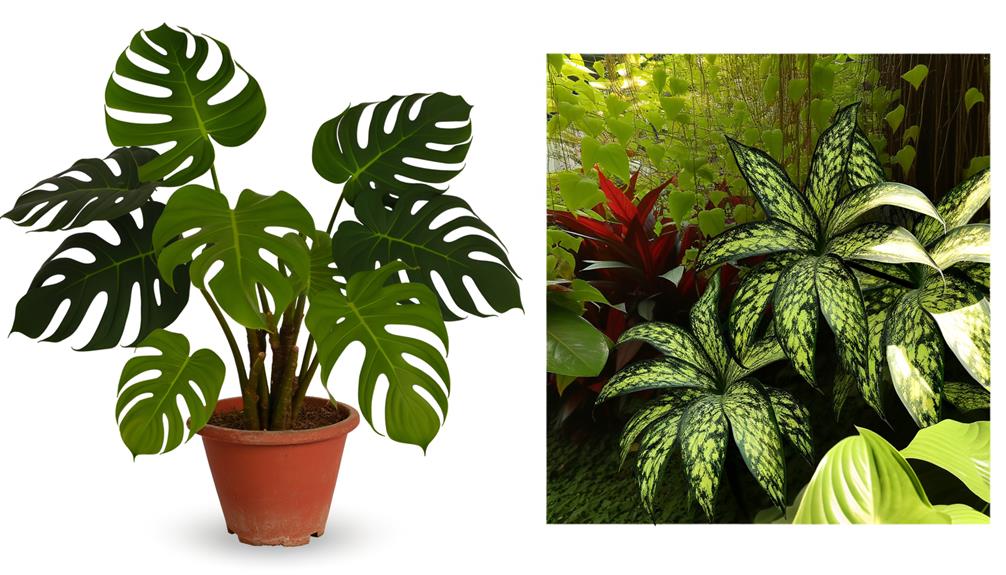
Originating from different parts of the world, Monstera Borsigiana and Thai Constellation present unique evolutionary adaptations and genetic variations.
Monstera Borsigiana hails from the tropical rainforests of Central and South America, specifically adapting to humid, low-light environments. This species has evolved aerial roots that enable it to climb and anchor to trees, optimizing its access to sunlight.
In contrast, the Thai Constellation is a cultivated variety, developed through tissue culture techniques in Thailand. Its genetic makeup is altered to produce striking variegation patterns, distinct from its natural counterparts. This controlled cultivation results in a plant with unique phenotypic traits.
Understanding these origins helps you appreciate the biological diversity and specialized adaptations that define each plant's survival and propagation strategies.
Appearance
The appearance of Monstera Borsigiana and Thai Constellation showcases distinct morphological traits that reflect their unique genetic variations and cultivation methods.
You'll notice that Monstera Borsigiana typically has deep green leaves with pronounced fenestrations, while Thai Constellation features variegated leaves with a marbled pattern of cream and green. This variegation is due to a stable mutation, making Thai Constellation highly sought after.
Key differences include:
- Leaf Shape: Monstera Borsigiana has more elongated leaves.
- Fenestration Pattern: Thai Constellation's fenestrations are often less symmetrical.
- Coloration: Thai Constellation's leaves have a marbled appearance.
- Stem Structure: Monstera Borsigiana exhibits a more trailing growth habit.
- Leaf Texture: Thai Constellation's leaves are thicker due to variegation.
These traits make identification straightforward.
Growth Rate
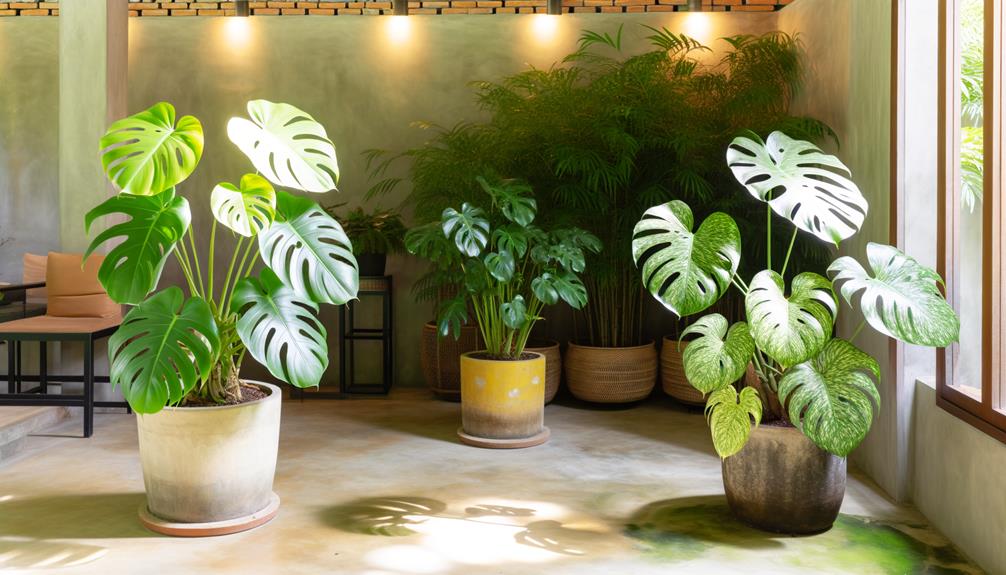
Monstera Borsigiana generally displays a faster growth rate compared to Thai Constellation due to its less variegated foliage, which allows for more efficient photosynthesis. The higher chlorophyll content in Borsigiana's leaves facilitates greater energy capture from sunlight, accelerating cellular processes such as mitosis and cell elongation.
In contrast, Thai Constellation's variegated leaves contain less chlorophyll, reducing photosynthetic efficiency and thereby, slowing its growth. You'll notice that Borsigiana can produce new leaves and aerial roots at a quicker pace under ideal conditions.
Additionally, environmental factors like light intensity, humidity, and nutrient availability greatly influence the growth rates of both plants. To maximize growth, ensure consistent care tailored to each plant's specific needs.
Leaf Size
As you observe their growth rates, you'll also notice a distinct difference in leaf size between Monstera Borsigiana and Thai Constellation. Monstera Borsigiana typically exhibits smaller leaves, often measuring around 12 to 18 inches in length.
In contrast, Thai Constellation leaves can grow considerably larger, reaching up to 24 inches or more. This disparity stems from the genetic variations between the two species, influencing cell size and leaf morphology.
- Monstera Borsigiana: Smaller leaves, 12-18 inches.
- Thai Constellation: Larger leaves, up to 24 inches.
- Cell Size: Thai Constellation has larger cells contributing to larger leaves.
- Leaf Morphology: Differences in leaf shape and structure.
- Genetic Variations: Key factor in leaf size differences.
Understanding these distinctions helps in identifying and caring for each plant.
Variegation Patterns
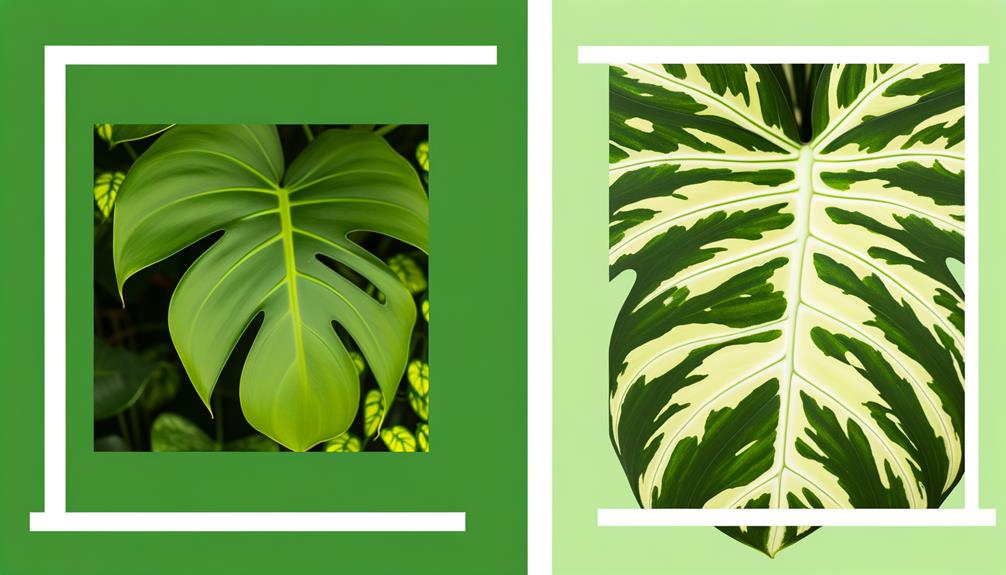
When examining variegation patterns, you'll notice distinct differences in color distribution between Monstera Borsigiana and Thai Constellation.
Monstera Borsigiana typically exhibits more irregular and less consistent variegation, while Thai Constellation showcases a more stable and predictable pattern.
Additionally, the stability of leaf variegation in Thai Constellation guarantees that new growth maintains its characteristic mottled appearance.
Color Distribution Differences
The variegation patterns in Monstera Borsigiana and Thai Constellation exhibit distinct differences, with the former showcasing irregular white splashes and the latter presenting stable, cream-colored marbling throughout its leaves.
You'll notice that Monstera Borsigiana's variegation is less predictable, often resulting in unique, asymmetrical patterns.
In contrast, Thai Constellation offers more uniformity, with its variegation being more consistent and evenly distributed.
Consider these key differences:
- Monstera Borsigiana: Irregular white splashes.
- Thai Constellation: Stable, cream-colored marbling.
- Pattern Uniformity: Borsigiana is less predictable.
- Color Consistency: Thai Constellation's variegation is more stable.
- Appearance: Borsigiana has a more chaotic, artistic look, while Thai Constellation appears more methodically patterned.
Leaf Variegation Stability
Understanding leaf variegation stability in Monstera Borsigiana and Thai Constellation involves examining the genetic consistency of their patterns.
Monstera Borsigiana exhibits a less steady variegation, prone to reverting to green under less favorable conditions. This instability is due to the plant's chimeric nature, where variegated and non-variegated tissues coexist.
Conversely, Thai Constellation boasts more steady variegation, attributed to its genetic engineering. This cultivar presents consistent white and cream speckles and sectors because of its stable genetic modifications.
For optimal variegation maintenance, you must ensure sufficient light conditions, as low light can trigger reversion in Borsigiana.
Understanding these genetic and environmental factors will help you maintain the desired variegation patterns in both Monstera varieties.
Light Requirements
Both Monstera Borsigiana and Thai Constellation thrive in bright, indirect light, with Monstera Borsigiana tolerating slightly lower light conditions compared to the Thai Constellation. You should place them near an east or north-facing window to avoid direct sunlight, which can cause leaf burn. Optimal light conditions will enhance photosynthetic efficiency and promote healthy growth.
Use a light meter to maximize 200-400 foot-candles.
Light Duration: Provide 12-14 hours of light daily.
Artificial Lighting: Supplement with full-spectrum grow lights if natural light is insufficient.
Leaf Position: Rotate the plant periodically to achieve even light distribution.
Light Monitoring: Regularly check for signs of light stress, such as yellowing or browning leaves.
Maintain these conditions for robust, vibrant plants.
Watering Needs
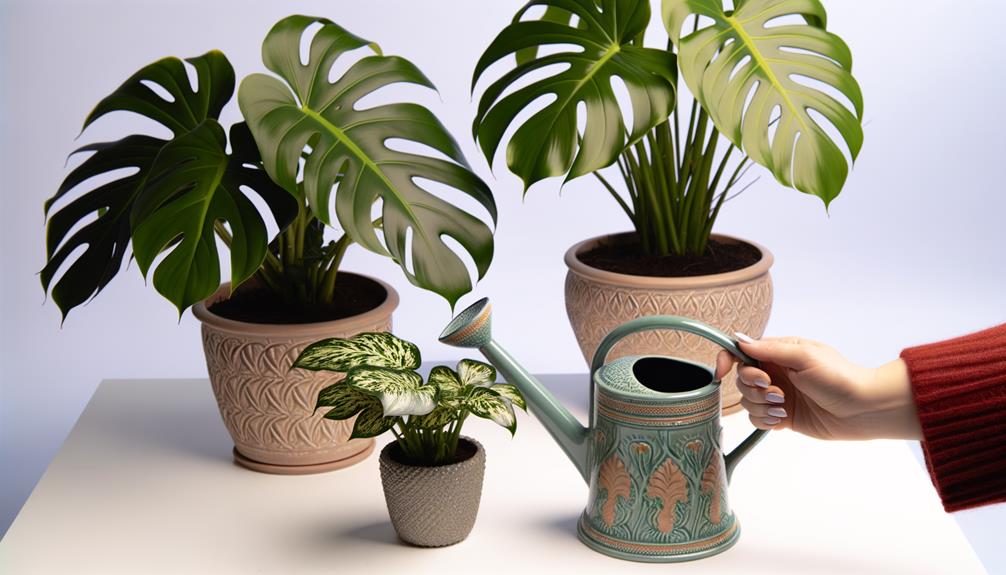
When addressing the watering needs of Monstera Borsigiana and Thai Constellation, you should focus on ideal watering frequency and soil moisture preferences. Both plants require consistent moisture levels, but it's important to avoid waterlogging.
Recognize signs of overwatering, such as yellowing leaves and root rot, to promote healthy growth.
Optimal Watering Frequency
Evaluating the best watering frequency for Monstera Borsigiana and Thai Constellation involves monitoring soil moisture levels and ensuring they're consistently moist but not waterlogged. You'll need to contemplate various factors to optimize hydration. Observe the soil and adjust your watering schedule based on environmental conditions.
Key aspects to monitor include:
- Humidity Levels: High humidity reduces the need for frequent watering.
- Temperature: Warmer temperatures can increase water evaporation.
- Soil Composition: Well-draining soil prevents waterlogging.
- Plant Size: Larger plants generally require more water.
- Growth Phase: Actively growing plants need more frequent watering.
Soil Moisture Preferences
To achieve perfect growth, Monstera Borsigiana and Thai Constellation require soil that maintains consistent moisture without becoming overly saturated. You should aim for soil that's well-draining yet retains sufficient hydration. Incorporate components like perlite, orchid bark, and peat moss to guarantee ideal moisture levels.
Water the soil when the top inch feels dry to the touch, guaranteeing even distribution without waterlogging. Utilize a moisture meter to measure soil moisture accurately, and adjust watering frequency based on environmental conditions such as temperature and humidity. Additionally, ensure containers have proper drainage holes to prevent water accumulation.
This balance in soil moisture supports healthy root development and overall plant essentiality, promoting robust growth and vibrant foliage.
Signs of Overwatering
Overwatering manifests through symptoms such as yellowing leaves, root rot, and a soggy soil surface. Both Monstera Borsigiana and Thai Constellation are susceptible to these conditions if you don't manage their water needs carefully. Identifying these signs early is essential to prevent irreversible damage.
- Yellowing Leaves: Chlorosis is a common indicator of excessive moisture.
- Root Rot: Fungal pathogens thrive in anaerobic, waterlogged soil.
- Soggy Soil Surface: Persistently wet soil inhibits oxygen availability.
- Leaf Edema: Water-soaked patches form due to cellular rupture.
- Foul Odor: Decomposing roots emit a characteristic unpleasant smell.
Soil Preferences
Both Monstera Borsigiana and Thai Constellation flourish in well-ventilated, nutrient-rich soil that maintains sufficient moisture without becoming waterlogged. You'll want to use a soil mix that balances organic matter with elements that promote good drainage.
| Component | Function |
|---|---|
| Sphagnum moss | Retains moisture |
| Pumice | Enhances aeration and drainage |
| Pine bark | Provides structure and aeration |
| Activated carbon | Prevents odor and toxins |
Incorporating these components ensures ideal root health by preventing compaction and root rot. Sphagnum moss and pumice are essential for moisture retention and aeration, while pine bark and activated carbon offer structural integrity and filtration benefits. This composition supports the plant's requirements for thriving growth and development.
Temperature Tolerance
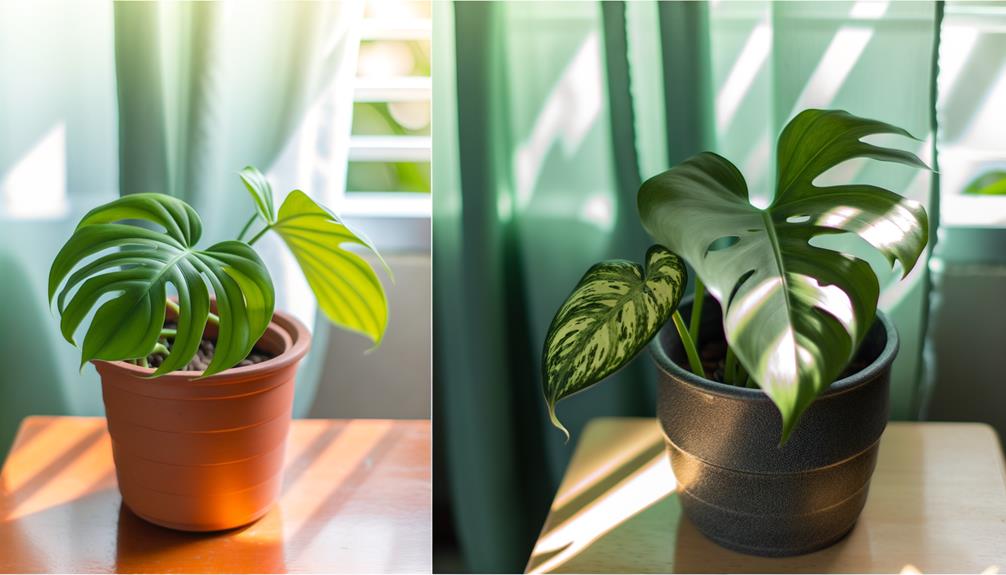
Understanding the temperature tolerance of Monstera Borsigiana and Thai Constellation is essential for promoting their growth and health. Both plants thrive in stable, moderate climates, avoiding extremes.
- Monstera Borsigiana: Prefers temperatures between 65-80°F (18-27°C).
- Thai Constellation: Ideal range is similar, around 65-77°F (18-25°C).
- Cold Sensitivity: Both species can suffer damage below 50°F (10°C).
- Heat Tolerance: Temperatures above 90°F (32°C) can cause stress and dehydration.
- Temperature Fluctuations: Rapid changes can lead to leaf damage and growth issues.
Maintaining these specific temperature ranges promotes the health of these tropical plants, encouraging strong foliage and vibrant variegation. Keep an eye on indoor and outdoor conditions to safeguard your Monstera varieties from temperature-induced stress.
Humidity Levels
Maintaining suitable moisture levels is crucial for the best growth and health of Monstera Borsigiana and Thai Constellation plants. Aim for relative moisture levels between 60-80%. High moisture fosters prime transpiration and nutrient uptake, preventing leaf browning and promoting vibrant foliage.
Use a hygrometer to monitor ambient moisture precisely. If levels fall below 60%, employ a humidifier or pebble tray to elevate dampness. Conversely, ensure proper air circulation to avoid fungal issues. Regular misting can also be beneficial but make sure water doesn't accumulate on leaves.
Consistently high moisture, around 70%, is particularly advantageous for Thai Constellation due to its variegation, which is more susceptible to stress from low moisture compared to Monstera Borsigiana.
Common Pests
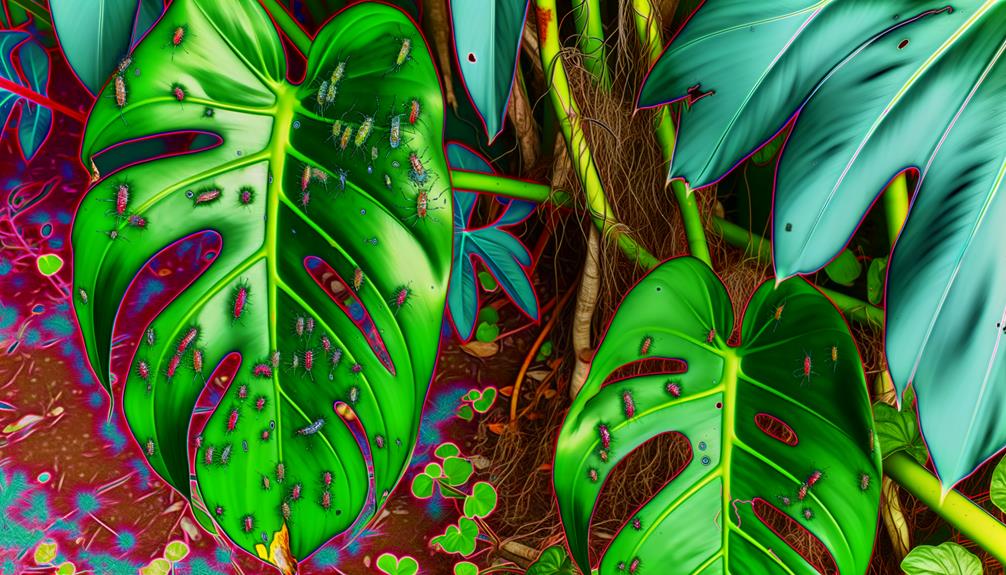
When caring for Monstera Borsigiana and Thai Constellation, you must identify common pests such as spider mites, mealybugs, and scale insects. Regular inspections and maintaining ideal humidity can greatly reduce infestations.
Implementing pest prevention tips, like using insecticidal soap and ensuring adequate air circulation, will help keep these pests at bay.
Identifying Common Pests
Identifying common pests on Monstera Borsigiana and Thai Constellation involves scrutinizing for signs of spider mites, mealybugs, and scale insects, which are prevalent nuisances for these plants. You should inspect leaf undersides and stems for these pests. Spider mites create delicate webbing and cause stippling on leaves.
Mealybugs appear as white, cotton-like masses, often clustering on leaf nodes. Scale insects manifest as small, brown or black bumps that can be scraped off. Additionally, you might notice yellowing leaves or stunted growth due to pest infestation.
Key indicators include:
- Delicate webbing indicating spider mites.
- White, cotton-like masses from mealybugs.
- Brown or black bumps from scale insects.
- Yellowing or browning of leaves.
- Stunted or distorted growth patterns.
Careful observation assures early pest identification.
Pest Prevention Tips
Effectively preventing common pests on Monstera Borsigiana and Thai Constellation involves implementing a regular inspection routine and maintaining ideal environmental conditions. You should inspect leaves and stems weekly for signs of pests like spider mites, aphids, and mealybugs. Utilize a magnifying glass to detect early infestations.
Maintain humidity levels around 60% to deter spider mites, and guarantee proper air circulation to prevent fungal gnats. Incorporate neem oil or insecticidal soap as part of your routine care, applying it every two weeks. Quarantine any new plants for at least two weeks to prevent introducing pests. Additionally, avoid overwatering, as it can lead to root rot and attract pests. Employ sticky traps to monitor for flying insects.
Conclusion
To sum up, your choice between Monstera borsigiana and Thai constellation hinges on nuanced botanical preferences. Monstera borsigiana's rapid growth and robust foliage might seem like a horticultural miracle, whereas Thai constellation's striking variegation resembles a celestial masterpiece.
Their soil, temperature, and humidity needs are exacting, demanding precision. However, mastery over these variables can yield jaw-dropping results.
With vigilance against common pests, you're poised to cultivate extraordinary specimens that transform any space into a verdant sanctuary.

